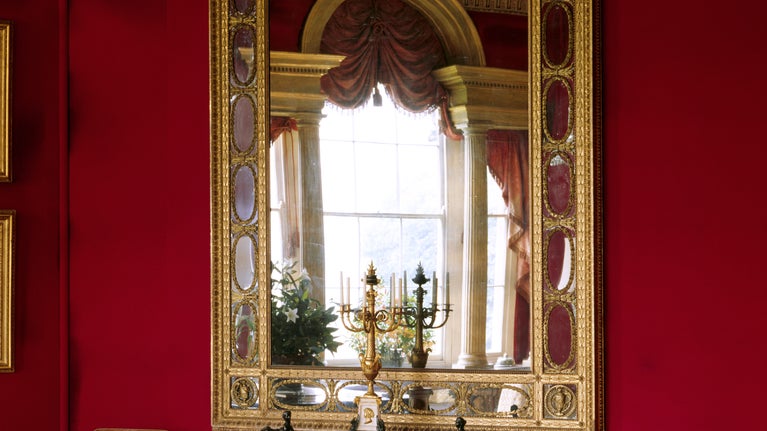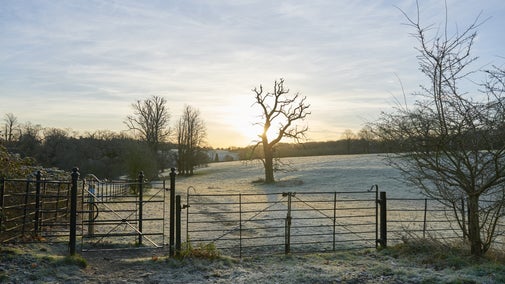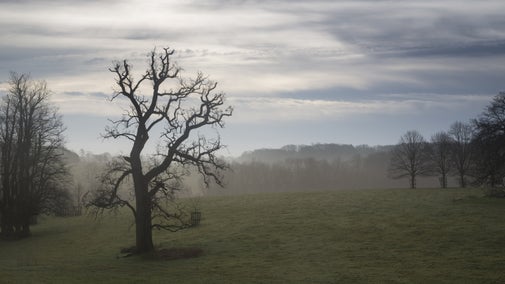
Discover more at Basildon Park
Find out when Basildon Park is open, how to get here, the things to see and do and more.

Basildon Park was built between 1777–83 with the fortune made by Sir Francis Sykes through his service with the East India Company. In 1838 it was purchased by James Morrison, Britain’s wealthiest commoner, who housed his spectacular art collection in the house. Basildon Park was saved from demolition in the 1950s by Lord and Lady Iliffe, after being requisition during the Second World War. They made Basildon Park their home, filling it with treasures rescued from other estates which could not be saved.
In the 1600 and 1700s, the Yonge family, merchants from Bristol, owned the manor of Basildon. In the 1680s, the estate passed to Henry Fane (d.1706) and passed down through his heirs. Some of the lodges built by his grandson survive, but little else does.
From John Roques’s 1762 map of Berkshire, we can see the early house was probably to the north of the current house and had a separate u-shaped stable block adjacent to it. The house and stable sat in a deer park, elements of which likely survive today.
Between 1720-1740, Lady Mary Fane built a famous grotto on the estate. Seemingly demolished in the nineteenth century, parts of the house attached to it survive (not in the care of the National Trust).
After the death of Charles, 2nd Viscount Fane (c.1706–66) the estate passed to his sisters who sold it to Sir Francis Sykes (1730–1804) in 1770. At first, Sykes lived in the existing house on the site. In 1777 however, he made the first payment to build a modern Palladian-style house which overlooked the River Thames, sited within a large landscape garden.
This new house and estate were a long way from Sykes’s origins in Yorkshire, where he had been born into a farming family at Thornhill near Dewsbury. After attending school, family connections meant he was able to join the East India Company as a Writer (a junior administrative position) sailing to India in February 1751. He spent the next 10 years living and working in the Indian province of Bengal.
In Bengal, he helped with the East India Company’s administration in controlling trade and exercising increasing control over the local populace. He returned to Britain in 1761, before going back to India as part of Robert Clive’s five-man Select Committee, working to assert the East India Company’s control over Bengal. Clive trusted Sykes as an administrator and diplomat, involving him in many important events and decisions.
This authority and position allowed Sykes to accrue considerable wealth. This was partly through the creation of monopolies on certain goods, including his participation with Clive’s Society Trade, but also through his own schemes. He also received many valuable gifts, including silks and diamonds from the nawab and other Indian nobles. Contemporaries estimated that he made one of the largest fortunes in India, bringing between £250,000-£500,000 (equivalent to hundreds of millions of pounds today) to England in 1769.
To build his new house at Basildon Park, Sykes hired Yorkshire architect, John Carr of York (1723–1807). It now remains Carr’s most important work in the south of England. Sykes’s attempts to become an MP led to increasing financial troubles, especially after he was found guilty of bribing electors. As a result, Basildon Park’s interior decorations were not completed in his lifetime.
Sykes’s eldest son, Sir Francis Sykes, 2nd Baronet (1767–1804) died shortly after his father, while escaping debts on the continent. The estate passed to his five-year-old son, Sir Francis Sykes, 3rd Baronet (1799–1843). Once he was old enough to inherit, he also spent extravagantly, further indebting the estate. The situation deteriorated further when he publicly accused his wife Henrietta of adultery with the artist Daniel Maclise. This led to considerable embarrassment for both husband and wife and as a result the two disappeared from public life. In 1838, Sykes sold the house to James Morrison (1789–1857) for £97,000 (which included £21,000 for the trees).

From humble origins, Morrison first made his fortune as a partner in his father-in-law’s wholesale haberdashery business. By 1830, he was the sole owner and had increased the annual turnover to over £2,000,000 – the equivalent of more than £3,000,000,000 today. He went on to create further wealth by investing in North American and French railways, as well as becoming an MP and joining the radical wing of the Whig Party.
Before purchasing Basildon, Morrison had begun to build an important collection of Old Master and contemporary paintings. It eventually included works by Rembrandt, Poussin, Constable and Turner. For Morrison, the purchase of Basildon allowed him to suitably display his collection, describing it as ‘…such a House and such a situation! What a casket to enclose pictorial gems.’
Morrison also employed the architect John Buonarotti Papworth to complete the decoration of the house’s interior, as well as to construct new gate lodges and other estate buildings. A dispute between the men led to Papworth’s dismissal and David Brandon designed the new stable block.
The house remained in the Morrison family until 1929. It was used as a convalescent hospital for officers of the Grenadier Guards in the First World War. In 1929, the newspaper proprietor Edward Iliffe (1877–1960), who owned the nearby Yattendon Estate, purchased the estate. He retained much of the land which bordered his own and removed seven doors and two chimney pieces for his London house. He then sold what remained of the house and estate to George Ferdinando (1869–1949), a London property developer.
Ferdinando was mainly interested in the stables and sporting opportunities. He planned to sell fixtures and fittings from the house before demolishing it. The London architectural salvage firm, Crowthers, began selling pieces. The ceiling paintings and fireplace from the Dining Room were sold and re-erected in New York’s Waldorf Astoria Hotel. Ferdinando then proposed selling the entire house for $1,000,000 to North America, but with no bidders, he instead decided to restore the house.
During the Second World War the house was used to house American troops. After they left, German Prisoners of War were housed in the woods nearby. Basildon Park was de-requisitioned by the War Office in 1952, by which time it was in very poor condition. It looked likely to join the long list of British country houses demolished at this time.
Langton (1908–1996) and Renee Iliffe (1916–2007) purchased Basildon in 1952, saving it from demolition. The couple fell in love with the house’s Georgian history and design and with dedication and investment, the Iliffes saved and restored the house.
They recovered the doors and chimneys that had been removed to London. Other architectural elements were salvaged from Panton Hall in Lincolnshire, another house designed by John Carr of York which was being demolished. The couple took advantage of the growing interest in the Georgian style and design to appropriately decorate the house with their own modern interpretation – often limited by what they could achieve with on-going post-war rationing.
They furnished the house with purchases from the many country house sales which took place at this time – houses which suffered the fate which Basildon was scheduled for before the Iliffes purchased it. This included the major sales at Ashburnham Place, Eaton Hall and Brockenhurst Park. They also created an important collection of 17th- and 18th- century European artwork which they felt suited the house, and includes important works by Pompeo Batoni, Giovanni Battista Pittoni and Charles de la Fosse.
In 1978, the Iliffes donated the house and estate and much of its collections to the National Trust. They remained living in the house’s South Pavilion until their deaths.
After taking over the property, the National Trust undertook a project to install a Shell Room, using the collection of shells which had been collected by Lord Iliffe’s mother, Lady Charlotte Iliffe (1881–1972). The room was inspired by the lost grotto house of Lady Fane and displays shells collected from around the world.
There have also been important acquisitions, such as a large part of the Chinese dinner service commissioned by Sir Francis Sykes in 1765-1770, purchased with support from the Iliffes and the Art Fund. The Iliffes made further donations from their art collection, such as ‘Garden Still Life’ (1774) by Anne Vallayer-Coster.
In more recent years, the Trust has marked Basildon Park’s links with India, by celebrating Diwali at the property and inviting a local artist to create a rangoli artwork inside the house for visitors to enjoy. There have also been exhibitions exploring the links between India and Berkshire over the past 250 years developed with the local community.


Find out when Basildon Park is open, how to get here, the things to see and do and more.
Discover the opulent styling and artistic treasures that make the house at Basildon Park a signature 18th-century Palladian mansion, including some quirky details.

Discover the beautifully laid out, restored grounds that surround the house at Basildon Park. Take in the views from the terrace and pause awhile under the thatched Umbrello seat.

Explore the wider estate on a parkland walk. Choose from one of four trails that are designed for different ages and abilities. Take in the views of the 18th-century Bath-stone house as it glows in the distance.

Read our report on colonialism and historic slavery in the places and collections we care for and discover how we’re changing the way we approach these issues.

Brown designed landscapes that fitted in seamlessly with the surrounding countryside. So how do you spot the designs of one of the greatest gardeners of all time?

Learn about people from the past, discover remarkable works of art and brush up on your knowledge of architecture and gardens.

Explore the objects and works of art we care for at Basildon Park on the National Trust Collections website.
